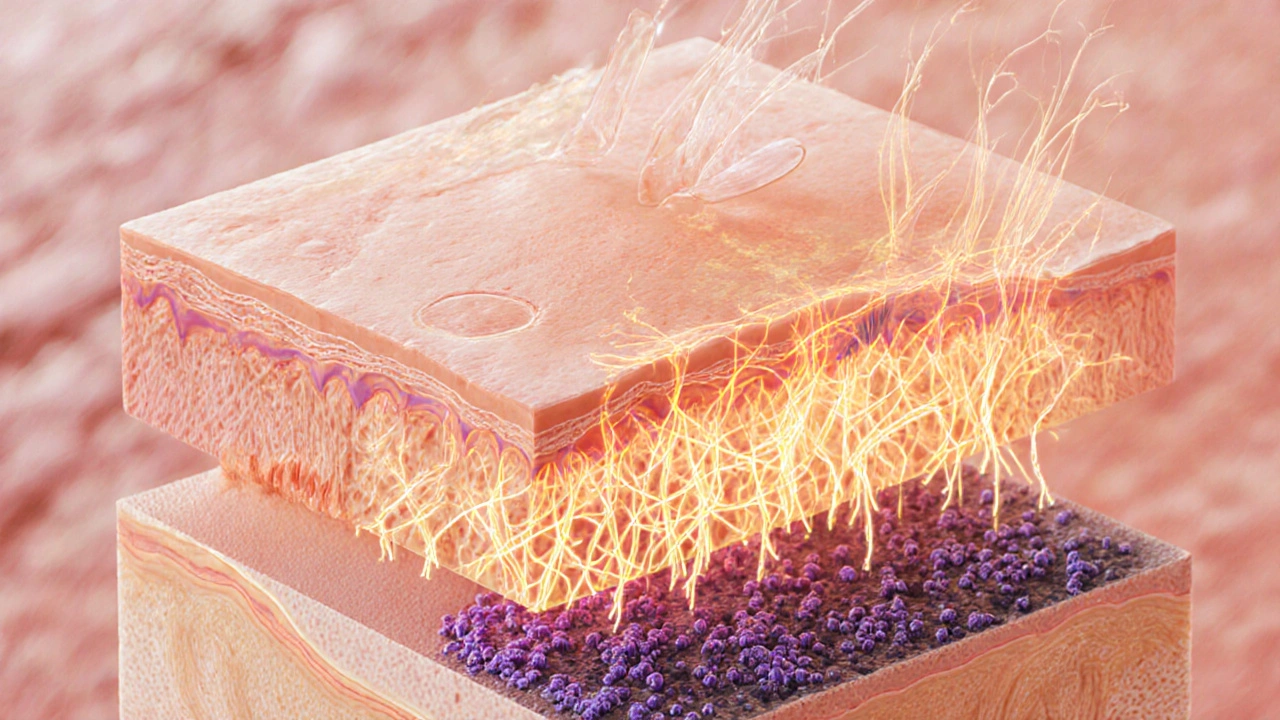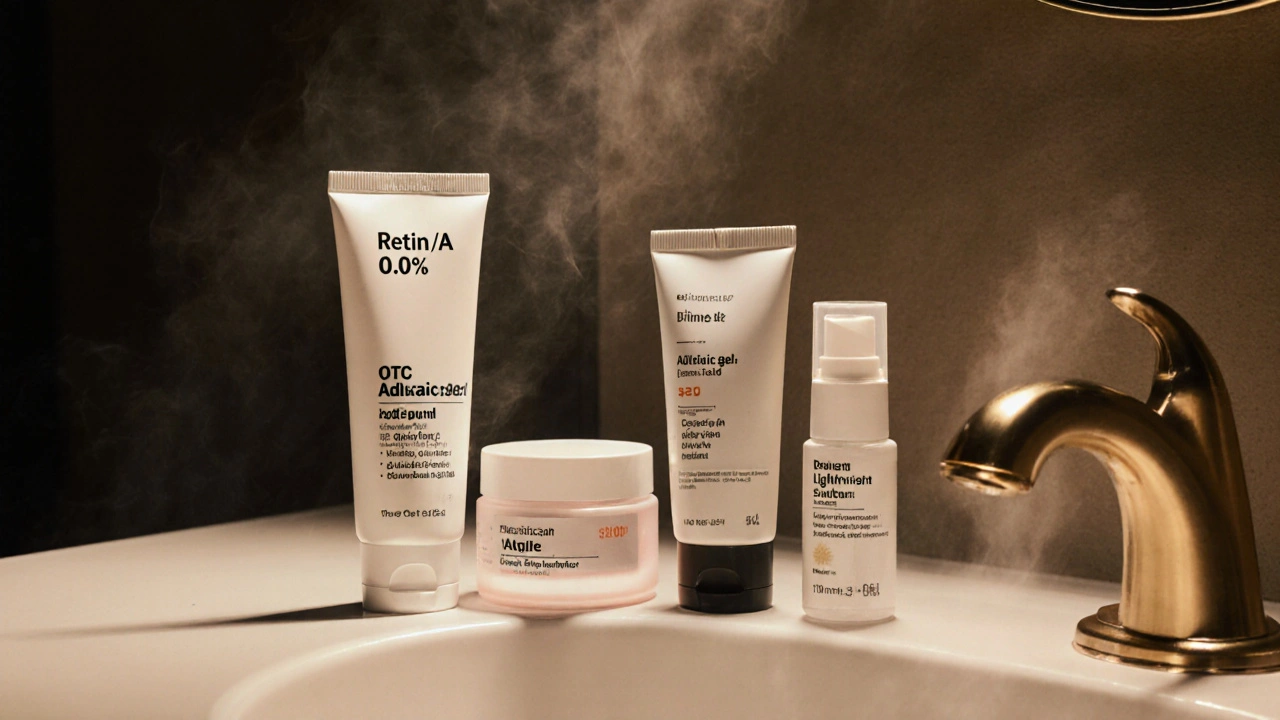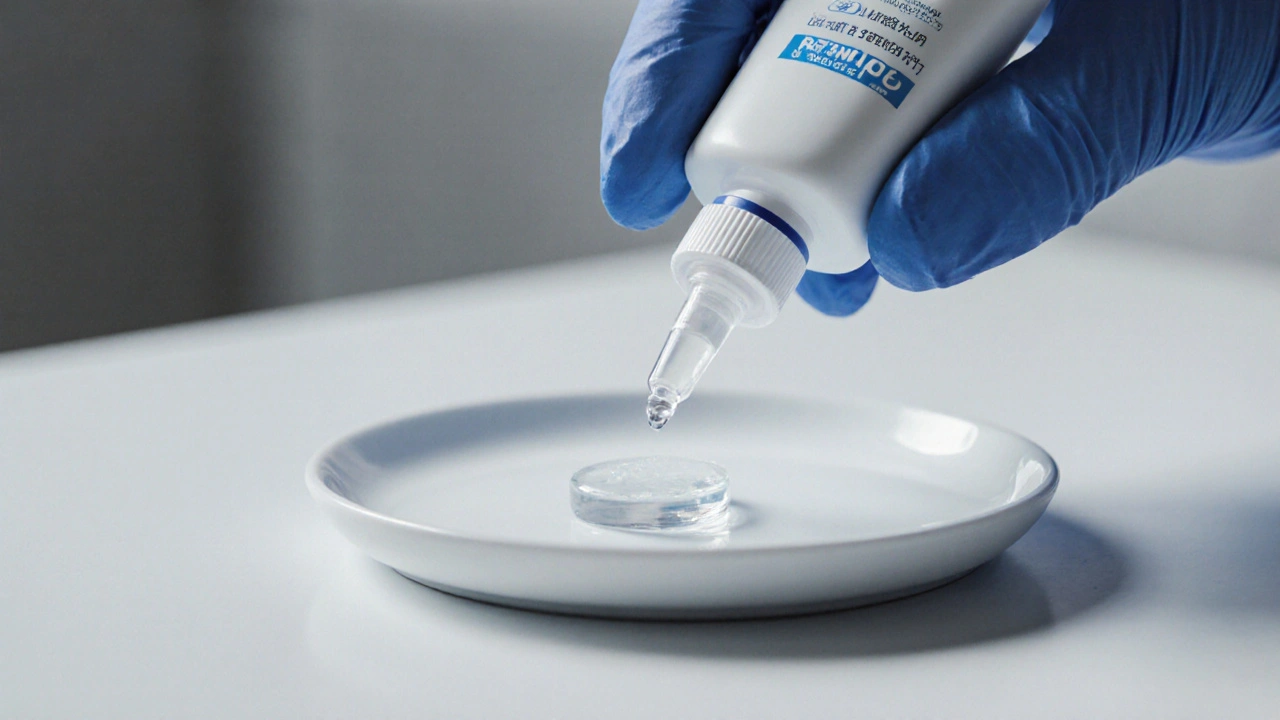Retinoid Selector Tool
Choose the best retinoid for your skin based on your specific concerns and skin type.
Recommended Retinoid
This recommendation is based on your inputs and the information in the article.
Key Takeaways
- Retin A 0.05% is a prescription‑strength tretinoin gel that delivers fast results for acne and signs of aging.
- Over‑the‑counter retinoids such as adapalene and retinol are gentler but work more slowly.
- Choosing the right product depends on skin sensitivity, treatment goals, and how quickly you need visible improvement.
- All retinoids can cause irritation; proper skin‑care routine and gradual introduction are essential.
- Consult a dermatologist before starting a prescription retinoid, especially if you have eczema, rosacea, or are pregnant.
What Is Retin A 0.05%?
When building a skincare regimen, Retin A is a prescription‑strength topical gel that contains 0.05% tretinoin, a synthetic form of vitamin A. It was first approved by the FDA in the early 1970s and has become the gold‑standard for treating both acne vulgaris and photo‑aged skin. The gel’s concentration-0.05%-offers a balance between efficacy and tolerability, making it a common starting point for many dermatologists.
How Tretinoin Works
Tretinoin belongs to the retinoid family, which binds to retinoic acid receptors (RAR) in the skin. This binding triggers three key actions:
- Accelerates the turnover of skin cells, helping clogged pores clear faster.
- Stimulates collagen production, reducing fine lines and improving texture.
- Regulates melanin distribution, fading hyperpigmentation over time.
Because it works at the cellular level, results typically emerge within 4-8 weeks, but the full transformation can take up to six months.

Benefits of Retin A 0.05%
- Fast‑acting acne control: Reduces comedones and inflammatory lesions within weeks.
- Anti‑aging power: Boosts collagen, smooths wrinkles, and evens tone.
- Clinically proven: Numerous studies confirm its superiority over lower‑strength retinoids for severe acne.
- Versatility: Can be used on the face, chest, and back where acne appears.
Common Over‑the‑Counter Alternatives
Not everyone wants a prescription, and several over‑the‑counter (OTC) retinoids provide milder results. Below is a quick snapshot of the most popular alternatives.
Adapalene is a third‑generation synthetic retinoid found in products like Differin Gel 0.1%. It is FDA‑approved for acne and is less irritating than tretinoin.
Tazarotene is a potent retinoid marketed under brand names such as Tazorac, typically at 0.05% or 0.1% concentrations. It is prescription‑only and works well for psoriasis and severe acne.
Retinol is the alcohol form of vitamin A found in many anti‑aging creams. It must be converted by the skin into tretinoin, making it slower but gentler.
Retinyl Palmitate is a fatty‑acid ester of retinol that is often included in moisturizers. Its conversion pathway is the longest, so results are subtle.
Azelaic Acid is a naturally occurring dicarboxylic acid that offers both antibacterial and keratolytic effects. It’s a solid option for sensitive skin and rosacea‑prone users.
Vitamin C (Ascorbic Acid) is an antioxidant that brightens skin and supports collagen synthesis. While not a retinoid, it pairs well with them for a comprehensive anti‑aging routine.
Side‑by‑Side Comparison
| Attribute | Retin A 0.05% (Tretinoin) | Adapalene 0.1% | Retinol (OTC) | Azelaic Acid 20% |
|---|---|---|---|---|
| Prescription status | Prescription only | OTC (in many countries) | OTC | OTC |
| Primary action | Cell turnover + collagen boost | Keratolysis + anti‑inflammatory | Gradual conversion to tretinoin | Anti‑bacterial + keratolytic |
| Typical onset of results | 4-8 weeks for acne, 3-6 months for wrinkles | 6-12 weeks | 12+ weeks | 4-6 weeks |
| Irritation potential | High (especially first 2-4 weeks) | Moderate | Low to moderate | Low |
| Best for | Severe acne, pronounced photo‑aging | Mild‑to‑moderate acne, sensitive skin | Early signs of aging, skin‑tone evening | Rosacea, post‑inflammatory hyperpigmentation |
How to Choose the Right Retinoid for You
Picking a retinoid feels a bit like choosing a workout plan-what works for a marathon runner may not suit a casual jogger. Use these decision criteria:
- Skin sensitivity: If you have a history of eczema or rosacea, start with adapalene or azelaic acid before moving to tretinoin.
- Urgency of results: For break‑out‑driven emergencies, prescription tretinoin gives the fastest clearance.
- Budget: OTC options are generally cheaper, but the slower progress may mean you’ll need a longer supply.
- Compatibility with other actives: Tretinoin should not be combined with strong acids (glycolic, salicylic) in the same routine; retinol can be layered with vitamin C.
- Pregnancy status: Tretinoin is contraindicated; azelaic acid and vitamin C are safer choices.

Practical Tips for Using Retin A 0.05%
Even the most potent formula can backfire if you rush it. Follow these steps for a smoother experience:
- Patch test: Apply a pea‑size amount on the jawline for three nights. Stop if you notice severe redness or swelling.
- Start slow: Use every third night for the first two weeks, then move to every other night, and finally nightly as tolerated.
- Apply on clean, dry skin: Wait at least 20 minutes after washing to ensure no water interferes with absorption.
- Use a pea‑size amount: More does not equal faster results; it just increases irritation.
- Moisturize first (the “sandwich” method): Apply a lightweight moisturizer, then the tretinoin, followed by another light layer of moisturizer.
- Sun protection is non‑negotiable: Broad‑spectrum SPF 30+ every morning; retinoids make the skin extra photosensitive.
If you experience flaky skin, reduce frequency or switch to a milder cleanser. Consistency wins over intensity.
When to Seek Professional Guidance
While many people manage retinoids at home, certain red flags warrant a dermatologist’s eye:
- Severe peeling that disrupts daily life.
- Persistent burning despite reduced frequency.
- Unexpected hyperpigmentation (especially in deeper skin tones).
- Concurrent use of isotretinoin or other systemic retinoids.
Professional assessment can adjust concentration, suggest adjunctive treatments (like niacinamide), or switch you to an alternative that aligns better with your skin’s tolerance.
Frequently Asked Questions
Can I use Retin A 0.05% if I have oily skin?
Yes. In fact, tretinoin can help regulate sebum production over time. Start with a low frequency and pair it with a lightweight, oil‑free moisturizer to avoid excess dryness.
How long should I wait before seeing noticeable improvement?
Most users report reduced comedones within 4‑6 weeks, but clear, smoother skin for anti‑aging benefits usually needs 3‑6 months of consistent use.
Is it safe to combine Retin A with vitamin C serum?
Yes, but apply them at different times of day. Vitamin C works best in the morning, while tretinoin is a night‑time treatment. This avoids potential irritation and maximizes each ingredient’s benefit.
Can pregnant women use any of these alternatives?
Pregnancy contraindicates tretinoin and tazarotene. Azelaic acid and vitamin C are considered safer, but always consult your OB‑GYN before adding any active ingredient.
What’s the main difference between Retin A and over‑the‑counter retinol?
Retin A delivers tretinoin directly to the skin, offering immediate cellular activity. Retinol must first be converted by enzymes into tretinoin, which slows the process and reduces irritation, making it gentler but less potent.
Bottom Line
If you need rapid acne clearance or want to tackle deep wrinkles, Retin A 0.05% remains the most effective retinoid on the market. For those with sensitive skin, a lower‑strength or OTC option-like adapalene or retinol-provides a gentler entry point. Weigh your skin’s tolerance, treatment timeline, and any medical constraints before deciding. And remember: consistency, sun protection, and a supportive moisturizer are the secret sauce that turns any retinoid into a results‑driving powerhouse.


Dawn Mich
October 13, 2025 AT 22:13Don't be fooled by the pharma lobby pushing Retin A as the "gold standard" while they secretly profit from the side effects that keep you buying moisturizers and sunscreens. The whole "prescription only" narrative is a way to keep the market captive.
Eric Sevigny
October 21, 2025 AT 20:02If you're just starting out with tretinoin, begin with the "sandwich" method: moisturize, apply a pea‑size amount of Retin A, then moisturize again. Keep the frequency low-every third night for two weeks-so your barrier can adapt without the dreaded peeling. Remember to wear SPF 30+ every morning; otherwise you’ll undo all the hard work.
Glenda Rosa
October 29, 2025 AT 17:51First, let’s dismantle the myth that “higher concentration equals better results” – the skin’s enzymatic machinery can only convert so much retinol to active tretinoin before it saturates. The table in the article hides the fact that adapalene’s keratolytic action is less pH‑dependent, making it more reliable for those with fluctuating skin oil levels. Secondly, the claim that tretinoin treats hyperpigmentation faster than azelaic acid ignores melanin’s long turnover cycle, which even the most potent retinoids can’t shortcut. Third, consider the socioeconomic angle: prescription retinoids create a barrier to entry, reinforcing a beauty hierarchy that favors those who can afford dermatologist visits. Fourth, the “gold‑standard” label was forged in an era before modern sunscreen formulations, so its relevance today is questionable. Fifth, many users report that alternating tretinoin with a retinol serum yields a cumulative collagen boost without the peak irritation bursts. Sixth, the article neglects the role of the skin microbiome; over‑aggressive retinoid use can disrupt bacterial balance, potentially aggravating acne rather than curing it. Seventh, the “sandwich” method is not a one‑size‑fits‑all – people with oily skin may benefit more from a lightweight gel barrier rather than a heavy cream. Eighth, the suggestion to avoid other actives like glycolic acid is overly cautious; a staggered schedule can actually synergize the exfoliation pathways. Ninth, the FDA’s approval timeline for tretinoin was based on older clinical endpoints that don’t capture modern quality‑of‑life metrics. Eleventh, if you’re pregnant, the article rightly warns against tretinoin, but it fails to mention that even low‑dose retinol can cross the placental barrier in small amounts. Twelfth, the cost analysis omitted generic tretinoin, which can be a fraction of the brand name price. Thirteenth, the table’s "high irritation" label for Retin A doesn’t account for the fact that pre‑treated, barrier‑strengthened skin can tolerate it almost as well as a milder retinoid. Fourteenth, the emotional toll of visible peeling can deter adherence, so psychosocial support should be part of any prescription plan. Fifteenth, the article’s focus on visible outcomes ignores subclinical improvements like DNA repair and telomere stabilization, which are equally important. Finally, the best retinoid is the one you’ll actually use consistently, regardless of its theoretical potency.
Aaron Perez
November 6, 2025 AT 15:40Choosing a retinoid is like picking a philosophical lens: some see the world in stark binaries, others in nuanced gradients. If you view skin as a canvas, tretinoin is the bold brushstroke that reshapes form, while retinol is the subtle wash that adds depth over time. Yet both are bound by the same rule of impermanence – nothing stays smooth forever without diligent care. The paradox lies in wanting instant transformation yet fearing the inevitable irritation. Embrace the process, and the skin will reward you with its quiet, resilient truth.
William Mack
November 14, 2025 AT 13:29Adapalene is the underrated workhorse for sensitive skin.
Evan Riley
November 22, 2025 AT 11:18Sure, the "sandwich" tip sounds innocent, but think about why dermatologists push moisturizers – they’re getting a cut of the skincare market too. If you truly want independence, go DIY with a simple mineral sunscreen and skip the overpriced creams.
Nicole Povelikin
November 30, 2025 AT 09:07Actually the article *does* mention generic tretinoin – you just have to scroll past the ads.
Michelle Weaver
December 8, 2025 AT 06:56Great analogy! 🎨 Remember to pair your retinoid with a gentle cleanser to preserve the skin’s natural barrier, especially if you’re experimenting with the "bold brushstroke" approach.